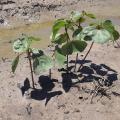Potassium Deficiency
In cotton, foliar symptoms of potassium deficiency that occur before peak bloom are similar to potassium deficiency symptoms found on other broadleaf crops. Interveinal yellowing first occurs on older leaves progressing to necrotic patches developing at leaf margins as conditions worsen. In many soils potassium supply is sufficient until peak bloom. At that time rapid dry matter accumulation in bolls begins, especially when a crop is fruited properly. At this point it is difficult for the soil to supply adequate potassium to meet the increased daily demand.
Late-season potassium deficiency results in foliar symptoms that differ from early-season deficiency. During and after peak bloom, deficiency symptoms will first appear on the younger mature leaves in the upper one-third of the plant. This is primarily because the developing bolls are the stronger sink for potassium being taken up from the soil each day. These symptoms will begin as a slight interveinal yellowing that will rapidly change to a bronze-orange color. These leaves then generally curl downward and will become thick, and necrotic patches will occur at the margins. As this problem develops boll retention decreases, and premature defoliation generally occurs. These symptoms can be so devastating that symptoms of late-season potassium deficiency are sometimes mistakenly attributed to a plant disease, especially Verticillium wilt. The two symptoms are distinct and a trained eye can spot the difference immediately. Verticillium wilt causes necrotic lesions between leaf veins that have well-defined borders and will generally be a brighter yellow than will potassium deficiency; then, they develop a rich brown color. The tell tail difference will be in the discoloration of the mainstem vascular tissue. If the foliar symptoms are confusing, cut the main stem of the plant in cross section. If the stem is filled with a dark streaking discoloration, the problem is Verticilium wilt. If the vascular tissue is clean, the problem is probably potassium deficiency. A tissue test cannot always tell the difference because Verticilium wilt will plug the stem preventing proper uptake and distribution of potassium, and other nutrients throughout the plant. It is interesting to note that proper potassium fertilization has been shown to reduce the incidence and severity of Verticillium wilt.
Publications
News
This summer has not just felt hot and dry; close to half the state is in moderate to severe drought, and temperatures have been mostly in the 90s through all of August.
Mike Brown is the state climatologist and Mississippi State University professor of meteorology. He said much of the northern two-thirds of the state has been fluctuating between drought and being OK.
STARKVILLE, Miss. -- Producers got a behind-the-scenes look at the wide scope of agricultural research taking place at Mississippi State University in an Aug. 6 event.
Cotton planting has all but drawn to a close in Mississippi for the year, with the state seeing an increase to an expected 500,000 acres in 2024. The U.S. Department of Agriculture made that acreage estimate and said the crop was 94% planted by June 9, 2024. Of that acreage, 80% was either in good or excellent condition, with 19% in fair and just 1% in poor condition.





